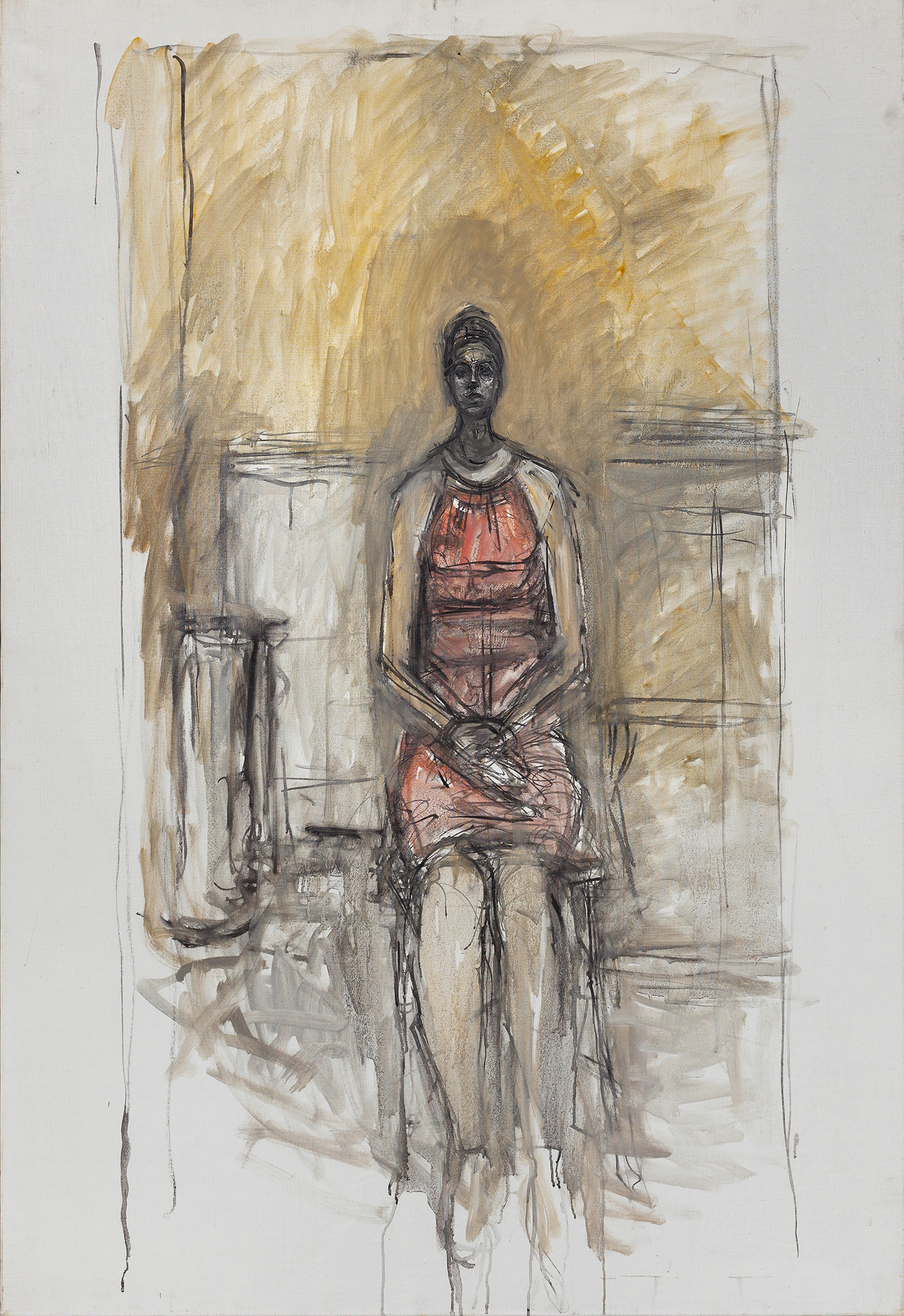
Caroline Seated Full-Length (Caroline assise en pied), ca. 1964–1965
“I see the person in front of me as a complex and contradictory thing, and so to understand it, I must copy it. In that way, I will see it better, I will discover it a little more. Consequently, I keep copying it.” [1]
Besides devoting himself to sculpture, the facet for which he is best known, Alberto Giacometti (1901–1966) was also an exceptional painter. Interested especially in the portrait and its capacity to reflect a likeness, the artist produced several works belonging to this genre, including outstanding portraits of his wife Annette Arm, his brother Diego, the writer Jean Genet, and the young Caroline, his last muse and lover.
In his portraits, he gives form to several obsessions that pursued him intensely throughout his work, such as the representation of the human figure, and particularly the head. From the 1950s on, his attention focused on existentialism and human frailty, which he explored with great creative impetus in pictures representing rigid, frontal figures isolated symbolically in space. [2]
Caroline Seated Full-Length is a picture painted in oil on canvas. It shows a young French prostitute that the artist had met in 1958 in the Montparnasse district, probably in a bar called Chez Adrien. Caroline was then 21. Born in the west of France, she had gone to Paris to find work and earn a living. Young and pretty, she had a strong personality, perseverance, and determination, qualities that Giacometti found attractive in a woman.
This painting can be regarded as one of the artist’s most personal works. Our attention is drawn both by the gaze of the sitter and the frontal view, with the model’s legs appearing in the foreground while the rest of the body is farther away, a technique Giacometti had already used in some of his sculptures. The head looks small in proportion to the rest of the body, a result of the artist’s determination to force the viewer to observe the work from a certain distance. On one occasion, Giacometti had said that we do not see people in their natural size, since it is in the eyes where the soul lives. This assertion was to form part of the theory behind his sculpture and painting.
In terms of technique, Giacometti combined an interest in spatial relations with a highly personal vision of the figures represented. This work is drawn with paint, using line and hatching to suggest both volume and space. In general, color is not a predominant feature of Giacometti’s painting. His portraits are generally sketched, with faces generated out of a multitude of dark lines, rather like preparatory drawings, in gray and black, hardly ever in warm colors. [3]
There was an age difference of 40 years between Giacometti and Caroline, but this did not prevent them from having a relationship during the last years of the artist’s life. Theirs was a tortuous affair, as he was still married to Annette while Caroline appeared and disappeared in his life, and even married another man. However, Caroline and the artist stayed together one way or another. They loved each other, traveled and lived together, and she posed for several portraits in Giacometti’s studio.
Preguntas
Look closely at this work painted by Giacometti in the last year of his life. It shows Caroline, his muse, and its title is Caroline Seated Full-Length. What kind of room do you think she is in? Can you imagine the place and what it looks like?
This is one of the last portraits the artist did of Caroline. What draws your attention about it? How is it different from other portraits you have seen before? Describe the young woman’s physical features.
Now pay attention to the way the picture is painted. Follow the lines as if you had a brush in your hand. How would you have to move the brush to paint this picture? Do you think Giacometti painted it in one go? Or do you get the impression he applied various layers on top of one another in different phases? What makes you think this? What are the predominant colors? Why would Giacometti have chosen to paint a picture that is almost monochrome?
If you look attentively, you will notice Caroline’s head is rather small in proportion to other parts of her body. What do you think is the reason for this peculiarity? What is the expression of her body? Why do you think she is sitting like that? Does it look like a comfortable position? Who decides the pose for a portrait, the artist or the model? Give reasons for your answers. If you were going to sit for a portrait, in what setting and pose would you like to appear?
In this work, Caroline appears on her own. If you could add some other element to the picture, what would it be? The room where she is portrayed seems completely empty. What furniture or decorative objects might you include? What colors would you use for this? Here, Caroline is portrayed full-length. How do you think your impression of this woman would change if she were shown only as a bust?
